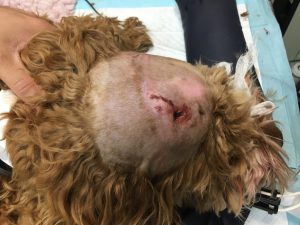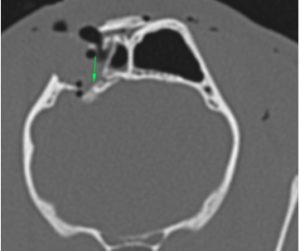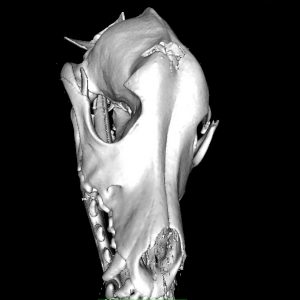Treating head and facial injuries following a dog attack
Milo – an 11 month old, male, mixed breed dog – presented as an emergency case at his local practice following an attack by another dog whilst out walking with his owner. His own vet
His own vet stabilised him on arrival and then arranged a transfer to our Hospital where he was assured attentive overnight care by our emergency out of hours team. However, due to the extent of his head and facial injuries – and following discussion with his own vet – it was decided that Milo would benefit from referral to our ECC team the next morning, rather than returning to the practice.
However, due to the extent of his head and facial injuries – and following discussion with his own vet – it was decided that Milo would benefit from referral to our ECC team the next morning, rather than returning to the practice.
Next morning Milo was quiet but alert, and apart from a slightly decreased menace response on his left eye, his neurological status was completely normal. He had two puncture wounds to his face.
The first was 5-7mm in diameter and located on the top of his head, extending into his frontal sinus. The second wound was 7-10mm in diameter and located on the lower left cheek.
Additionally, he had mild scleral haemorrhage on his left eye.

Milo was placed under general anaesthesia and an on-site CT scan of his head was performed.
This revealed that Milo had a comminuted fracture of the right frontal bone with a depression fragment compressing the right frontal lobe, associated with perilesional oedema and subdural haemorrhage.
He also had an incomplete fracture of his left frontal bone, a displaced fracture of the left zygomatic arch, as well as subcutaneous emphysema and hematoma of the soft tissue on the left side of his face.
Drawing upon the multi-disciplinary experience within the referral team, our Surgeon assessed Milo’s wounds and reviewed the CT scan images. The puncture wounds were clipped, cleaned and a tie-over bandage was placed to cover the puncture wound extending through the frontal bone.
Neurological examination confirmed no sign of damage, and susequently no surgical intervention was required.
Milo was hospitalised and treated conservatively with IV antibiotics (amoxicillin/ clavulanic acid 20mg/kg q8h) and analgesics (fentanyl CRIs – switched later to methadone, as well as paracetamol and carprofen).
His tie-over bandage was changed daily.
A repeated haematology performed three days after the attack showed an improving inflammatory response. His wounds closed by
His wounds closed by second intention over the week-end, and six days after the attack Milo was discharged without any clinical signs.



